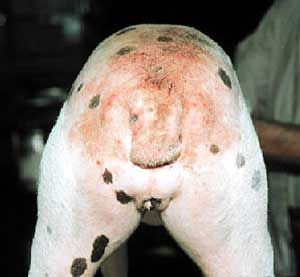Flea allergy dermatitis

Flea Allergy Dermatitis (FAD) is a hypersensitive reaction to the saliva of fleas that affects both domestic and wild animals, and occasionally humans. It is the most common skin disease among dogs and cats. FAD is characterized by intense itching, leading to excessive scratching, biting, and licking of the skin. This article provides an overview of the causes, symptoms, diagnosis, treatment, and prevention of Flea Allergy Dermatitis.
Causes[edit]
Flea Allergy Dermatitis is primarily caused by an allergic reaction to flea bites, specifically to the proteins found in flea saliva. When a flea bites an animal, it injects saliva into the skin. For animals with FAD, even a single flea bite can trigger an intense allergic reaction due to their hypersensitivity to flea saliva.
Symptoms[edit]
The most noticeable symptom of FAD is severe itching (pruritus), which can lead to the animal's excessive scratching, licking, or biting at the site of the flea bite. This can result in:
- Hair loss
- Reddened skin
- Hot spots (acute moist dermatitis)
- Secondary skin infections
The back end of the animal, especially the area just above the tail, is most commonly affected. However, lesions can appear anywhere on the body.
Diagnosis[edit]
Diagnosis of Flea Allergy Dermatitis typically involves:
- Clinical examination and history: A veterinarian will look for signs of fleas, flea dirt, or flea eggs on the animal's body, and will consider the animal's history of itching and skin problems.
- Intradermal skin testing: This may be performed to confirm an allergy to flea saliva.
- Serology: Blood tests can identify the presence of antibodies to flea antigens.
Treatment[edit]
Treatment of FAD focuses on three main areas:
- Flea control: It is crucial to eliminate fleas from both the animal and its environment. This may involve the use of topical or oral flea control products, environmental sprays, and regular cleaning of bedding and other areas where the animal spends time.
- Managing skin infections: Secondary bacterial or fungal infections resulting from the scratching and skin damage need to be treated with appropriate medications.
- Reducing inflammation and itching: Corticosteroids or other anti-inflammatory drugs may be prescribed to control itching and reduce inflammation.
Prevention[edit]
Preventing Flea Allergy Dermatitis primarily involves rigorous flea control measures to minimize the animal's exposure to fleas. This can include:
- Regular use of effective flea control products on the animal
- Regular cleaning of the animal's living environment
- Using flea preventive measures year-round, as fleas can survive in many environments
Conclusion[edit]
Flea Allergy Dermatitis is a distressing condition for affected animals but can be managed effectively with appropriate treatment and preventive measures. Early intervention is key to preventing severe skin damage and secondary infections. Pet owners concerned about FAD should consult a veterinarian to develop an effective management plan.
Ad. Transform your life with W8MD's Budget GLP-1 injections from $75


W8MD offers a medical weight loss program to lose weight in Philadelphia. Our physician-supervised medical weight loss provides:
- Weight loss injections in NYC (generic and brand names):
- Zepbound / Mounjaro, Wegovy / Ozempic, Saxenda
- Most insurances accepted or discounted self-pay rates. We will obtain insurance prior authorizations if needed.
- Generic GLP1 weight loss injections from $75 for the starting dose.
- Also offer prescription weight loss medications including Phentermine, Qsymia, Diethylpropion, Contrave etc.
NYC weight loss doctor appointmentsNYC weight loss doctor appointments
Start your NYC weight loss journey today at our NYC medical weight loss and Philadelphia medical weight loss clinics.
- Call 718-946-5500 to lose weight in NYC or for medical weight loss in Philadelphia 215-676-2334.
- Tags:NYC medical weight loss, Philadelphia lose weight Zepbound NYC, Budget GLP1 weight loss injections, Wegovy Philadelphia, Wegovy NYC, Philadelphia medical weight loss, Brookly weight loss and Wegovy NYC
|
WikiMD's Wellness Encyclopedia |
| Let Food Be Thy Medicine Medicine Thy Food - Hippocrates |
Medical Disclaimer: WikiMD is not a substitute for professional medical advice. The information on WikiMD is provided as an information resource only, may be incorrect, outdated or misleading, and is not to be used or relied on for any diagnostic or treatment purposes. Please consult your health care provider before making any healthcare decisions or for guidance about a specific medical condition. WikiMD expressly disclaims responsibility, and shall have no liability, for any damages, loss, injury, or liability whatsoever suffered as a result of your reliance on the information contained in this site. By visiting this site you agree to the foregoing terms and conditions, which may from time to time be changed or supplemented by WikiMD. If you do not agree to the foregoing terms and conditions, you should not enter or use this site. See full disclaimer.
Credits:Most images are courtesy of Wikimedia commons, and templates, categories Wikipedia, licensed under CC BY SA or similar.
Translate this page: - East Asian
中文,
日本,
한국어,
South Asian
हिन्दी,
தமிழ்,
తెలుగు,
Urdu,
ಕನ್ನಡ,
Southeast Asian
Indonesian,
Vietnamese,
Thai,
မြန်မာဘာသာ,
বাংলা
European
español,
Deutsch,
français,
Greek,
português do Brasil,
polski,
română,
русский,
Nederlands,
norsk,
svenska,
suomi,
Italian
Middle Eastern & African
عربى,
Turkish,
Persian,
Hebrew,
Afrikaans,
isiZulu,
Kiswahili,
Other
Bulgarian,
Hungarian,
Czech,
Swedish,
മലയാളം,
मराठी,
ਪੰਜਾਬੀ,
ગુજરાતી,
Portuguese,
Ukrainian
